 |
 |
Halewood Local History Pages The Buildings of Halewood
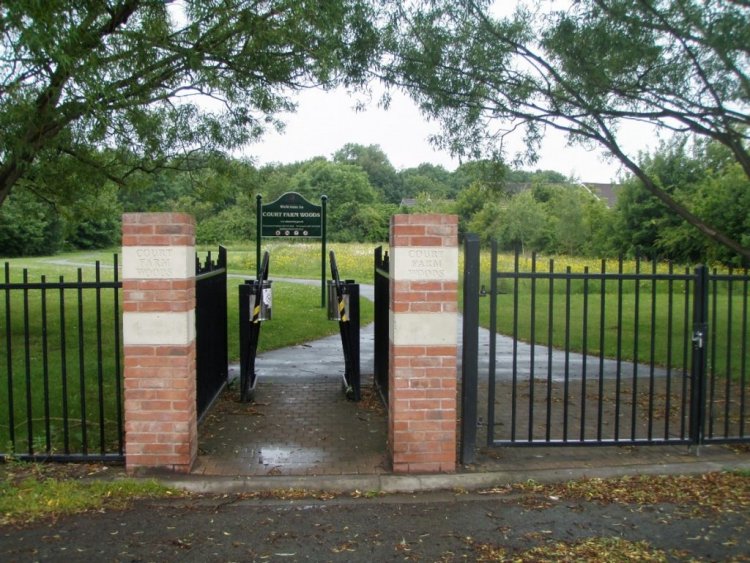 Court Farm Woods
In the eighteenth century, the Court Farm site was a small farm, probably a Georgian brick built design similar to other farms in the surrounding area. The Estate Map of the Earl of Derby surveyed in 1783 (produced as part of the land and farming improvements being introduced during the Agricultural Revolution) shows a couple of small buildings, although it is difficult to judge the size from the map. The name Court Farm was not introduced until the late nineteenth century. 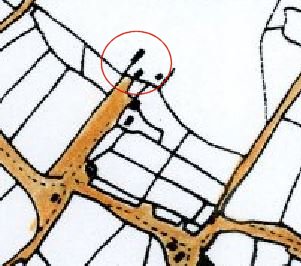
Earl of Derby estate map (extract) 1783
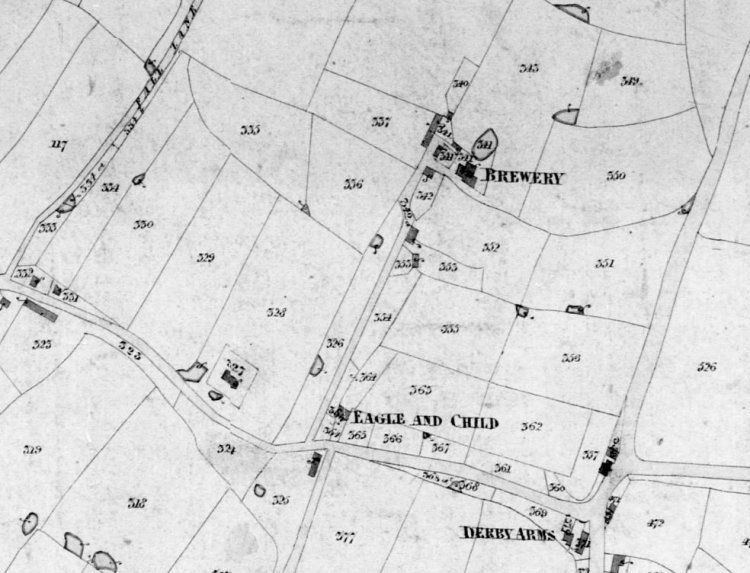
Halewood Tithe map (extract) 1840
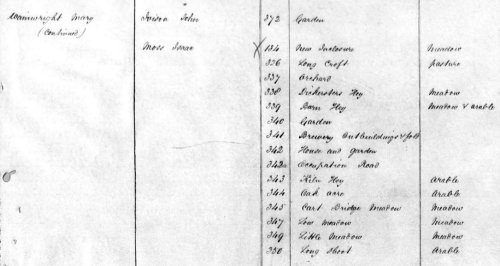
Halewood Tithe map apportionment (extract) 1840 The brewery and village in the mid 1840s
(It would seem this site fell into disrepair on his vacating of the property. By the end of the century it had been demolished. During the twentieth century Ditton Fold Farm was built on the site.) In a directory entry of 1825 (right), Isaac Moss, by then aged thirty-one, is recorded as a 'brewer etc.' - he may have been at the Lower Road farm carrying on domestic brewing, while the 'etc' suggests he is also farming. The date of his exact move to the Court Farm site is as yet unknown, and there is no documented link until 1840. A obituary of Edward Moss, Isaacs son, noted that the family had been brewing in Halewood for half a century [Edward Baines & William Parson, History, Directory, and Gazetteer, of the County Palatine of Lancaster (1825) ]
In 1830, the Beerhouse Act liberalised the regulations governing the brewing and sale of beer. It enabled any rate-payer to brew and sell beer on payment of a licence costing two guineas. The intention was to increase competition between brewers; lowering prices and encouraging people to drink beer instead of strong spirits. It resulted in the opening of thousands of new public houses and breweries throughout the country, particularly in the rapidly expanding industrial centres of the north of England. According to the Act, Parliament considered it was; "expedient for the better supplying the public with Beer in England, to give greater facilities for the sale thereof, than was then afforded by licences to keepers of Inns, Alehouses, and Victualling Houses."
It seems to have been this Act, given the timing, that was the catalyst for change on the old Court Farm site. By this time, production methods had changed, creating major breakthroughs leading to breweries having the facility to produce the same beer consistently. The steam engine, vastly improved in 1775 by James Watt, brought automatic stirring mechanisms and pumps into the brewery. It gave brewers the ability to mix liquids more reliably while heating, particularly the mash, to prevent scorching, and a quick way to transfer liquid from one container to another. The steam engine also allowed the brewer to make greater quantities of beer, as human power was no longer a limiting factor in moving and stirring. The site was soon developed to consist of a large residential house, plus croft, a farm, building land and cottages, while the brewery was measured as being forty-eight barrels in length, and fitted out with modern machinery to carry on an extensive business, with steam engines, coppers, machinery and fixtures, plus outside a stable block and associated buildings to house the dray horses. The site also benefitted from an excellent supply of spring water, suitable for brewing first class ales. Thomas Revell, a cooper making barrels and metal hoops resided close by in Tunstall's Lane, and was no doubt kept busy by the brewery. To ensure a regular uptake in supplying the local area, the brewery acquired five licenced Public houses and two beer-houses, in Woolton, Garston, Wavertree, Whiston, St Helens, Eccleston. Breweries started to use agents to identify households where a beerhouse could be established, but would tenant the property, supply the barrelage and pay the excise fee and the rates. This then created more outlets for their beer and ale. The brewery received a huge blow on 28 February 1856, when brewer Isaac Moss died aged sixty-two. He was buried in St Nicholas churchyard, just a few yards from his home. The incumbent, Reverend Jabez Jones, noted in the register against his name 'The first Warden of Halewood Church, appointed in 1839 [the year of construction], and continued in office until his death, February 28th 1856'.Following Isaac's passing, their family estates and cottages in the Halebank end of Halewood Township were put up for sale and three years later, in June 1860, the Brewery was put up for auction. Eldest son Edward may have become disillusioned with the business, or it may have run into financial difficulties.
It seems the auction failed or was withdrawn, as Edward Moss continued to run the Halewood Brewery as a going concern.
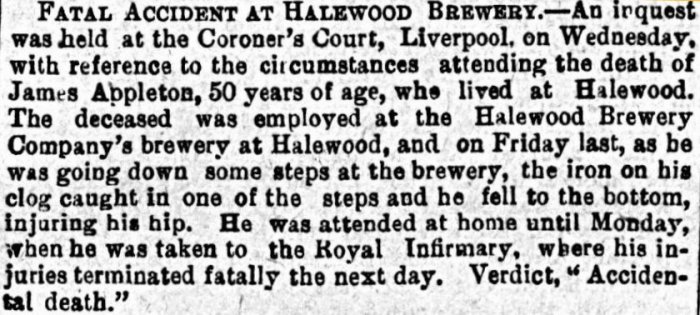
Fatal accident at the Brewery Widnes Examiner 19 September 1885
By 1877, there was another crisis when Edward, Isaac's eldest son, passed away unmarried, leaving no children. By this date his siblings, Sarah (1874), John (1841), Anne (1866), Isaac (1848), Thomas (1863), and James (1873), had all passed away too. This left his unmarried sister Elizabeth aged fifty, who had no interest in taking on the brewery by herself. Consequently, James' widow, Sarah Moss, moved her family to the Brewery. Until the passing of her husband James, they had been living at neighbouring Bridgefield, while James worked with his father and brother in the Brewery. In 1881, James' twenty-three year old son James jnr is recorded as an unemployed brewer, suggesting the Brewery was now closed, and younger son John, aged twenty-one, was a travelling commercial brewer, sugggesting he was on the road trying to make use of his skills elsewhere. By 1882, they clearly had had enough, and again the Brewery was put up for auction; 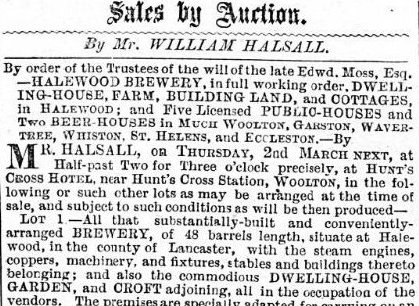
Brewery was put up for auction
Whether or not the sale was successful and who the purchaser was if any is still unclear. It is certain that the Brewery was in the hands of shareholders by 1885 and not a single owner. However, a close neighbour John T. Wood, who resided at Foxhill did move in, although the exact date is unknown and whether or not it was a lease. This will be returned to shortly. Brewery manager John Ockleshaw, carried on the day to day management of the business, while living on site in Brewery House. The finances were certainly in a good state by 1885, however, in that same year, there was a truly dreadful incident at the Brewery House, that had broad implications for the business;
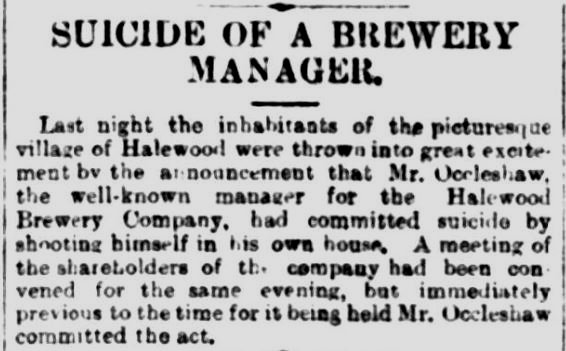
Liverpool Echo 14 January 1885 In such a small village this was devasting news, and rumours flew around as to what drove such a respected member of the tight-knit community to commit such an act, and in his own home too, while his family were closeby. Thoughts, understandably, began to turn to the meeting of the shareholders that the newpapers reported was due to take place imminently. Could this have had a bearing on his state of mind? Were there irregularities he was just too afraid of, or ashamed to face? No doubt guilt set in amongst those who had such thoughts, or who had promoted their pointed gossip, when the tragic truth became clear; 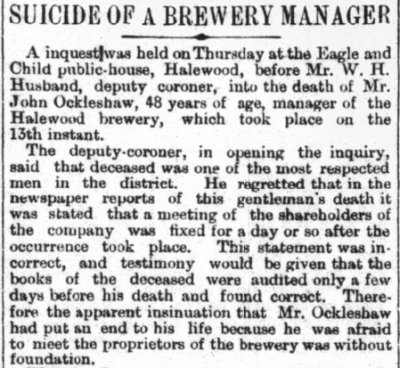
The Inquest (click for full article)
Departure of the Moss Family How this awful incident affected the Moss family is unknown, but they left Halewood Brewery and moved to 'The Thorns' in Liscard Village, Wirral. Although, not John Moss however, as he married his childhood sweetheart from Halewood, Catherine Thorburn, in 1887 and moved to Crosby, then to Wallasey Village, where he and Catherine brought up four daughters. He died in 1929. His older brother James died in Liscard on 4 December 1889 aged only thirty-one, leaving estate worth the equivalent of £160,000 to Sarah, his mother (which suggests the auction was succesful and the Brewery business sold to a number of unknown shareholders). James was buried in St Nicholas, Halewood, as was his youngest brother Okill, who died two years later in 1891. Sarah and her family moved again, firstly to a house in New Brighton, then by 1911 to Kremlin Drive in Stoneycroft, Liverpool, from where Sarah's third son, Edward, enlisted for the 3rd Battalion, Worcestershire Regiment in August 1914, as Private 8646 Edward Moss. By 20 October 1914, he had been killed in action. His body was never found, and he was remembered on Le Touret Memorial in France. He was not recorded on the Halewood War Memorial. Despite the family not having lived in the village since the 1880s, this is an unfortunate omission, given their long ties with Halewood.
The Halewood Brewery meanwhile, following the tragic demise of John Ockleshaw, was now to be managed by his son William, but again it was put up for auction in 1893. However, this time it was to sell off the stock and shut it down for good.
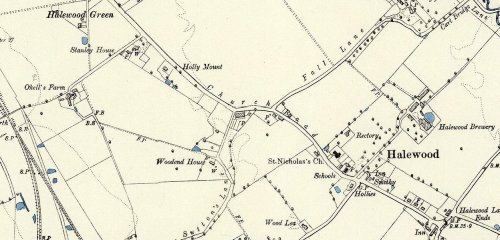
Halewood Brewery 1894
Although born in Aspull near Wigan on 5 March 1849, his father was a farmer who had once worked on a farm at the Halebank end of Halewood Township, at the end of the Ditton Brook, where the Ditton Ironworks were later constructed. In Aspull, John was brought up on the farm of 50 acres where his father employed four men. By the age of twelve, he was attending grammar school in Wigan, and boarding at the family home of one of his masters. By 1871, now aged 22 and a civil engineer, he had returned to the family home, where his father had now moved to West Kirby. But his stay was a short one, as two years later he married Alice Anne Fisher More, daughter of the late Thomas Fisher More who had been an iron merchant and cotton spinner in Wigan. John trained as an engineer and worked with the City Engineer of Liverpool, before relocating to Cambridge. On his return to the Liverpool area and his purchase of The Court, he also intended to enter local politics - from which this detailed biographical portrait emerged;
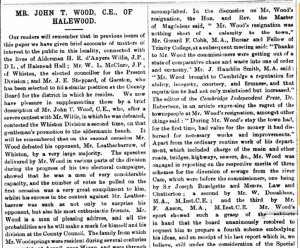
Mr J.T. Wood C.E.
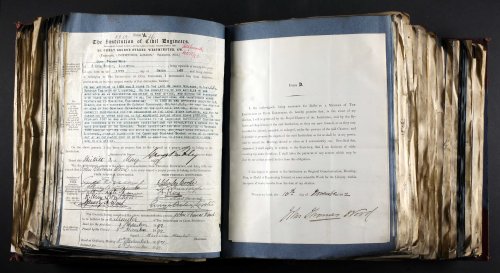
Mr J.T. Wood C.E. - Member of the Institution of Civil Engineers 30 May 1892

After a short period in Wavertree, they moved to Halewood taking a lease on Foxhill House. While continuing his work as a civil engineer for Liverpool Corporation, he also maintained the farm of forty acres, employing two men. In August 1876, their son William Brownbill Wood was born in Halewood, and later baptised in St Nicholas Church. He later also qualified as a civil engineer. Adapting to village life in Halewood, he became a regular attendee of St Nicholas and was the first captain of the church bellringers, the new peal and tower having been dedicated in August 1883. Meanwhile, he also continued to pursue his polical career, and was elected as an Alderman to Lancashire County Council in the 1890s. In September 1904 his wife, Alice Anne Wood died. She was buried in St Nicholas Churchyard, just a few yards from their home.
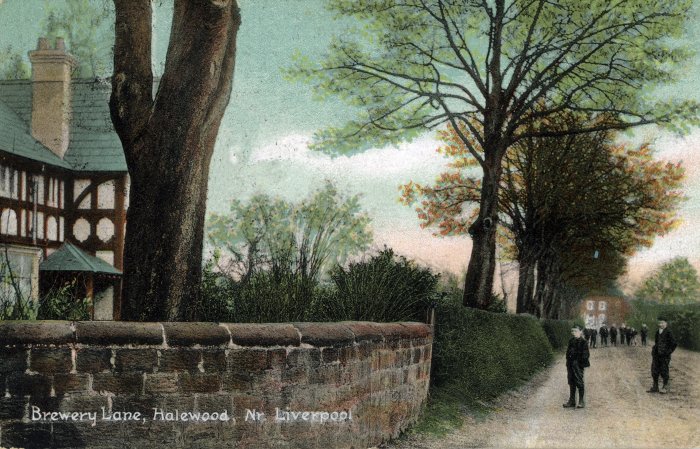
Brewery Lane (c.1910)
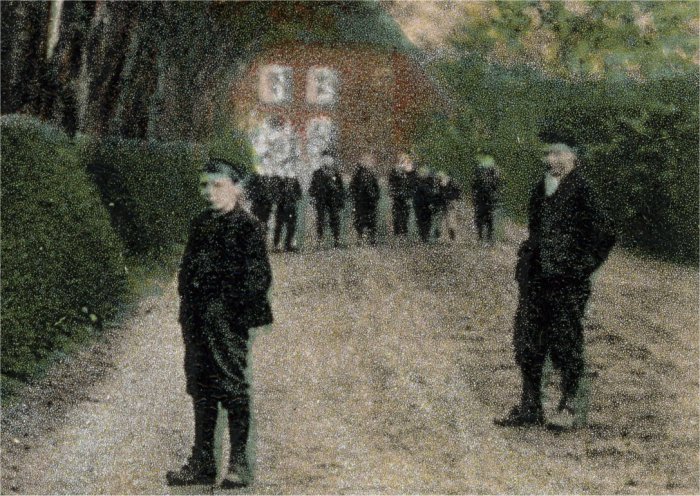
Schoolboys in Brewery Lane, with a glimpse of The Court at the end of the lane (c.1910)

Schoolgirls in Court Avenue (c.1910)

The Court 1905
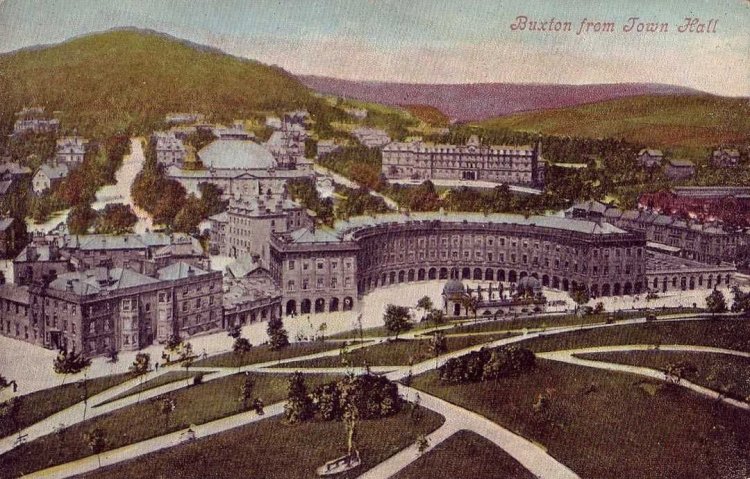

Marriage register - John Thomas Wood and Milbra Ann Green
His son William passed away at Riverside in Parkgate on 7 March 1946.
Okells Farm / Lyon's Farm and the Grace FamilyBilly Grace, the new owner of The Court, was born close by at Okell's Farm, a few hundred yards further along Church Road towards Woolton. The Grace family and their relatives had farmed various sites in Halewood for decades. It was Billy's father, William Grace, who first came to Okells. The previous tenant was the Turton family who farmed the Halewood Green area for over a century. Before the Turtons, a Land Tax document of 1798 records James Pennington as tenant.
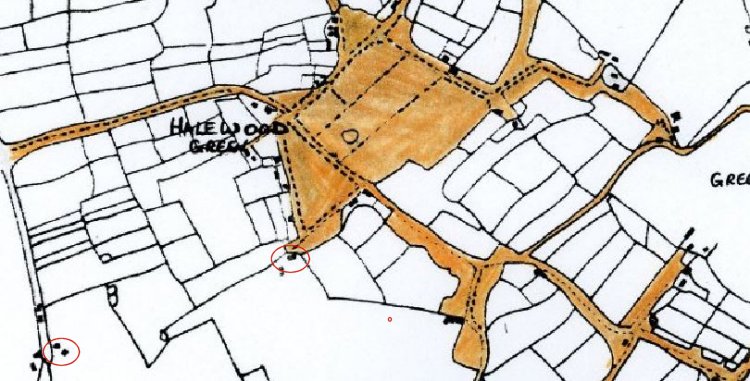
Lord Derby Estate Map 1783
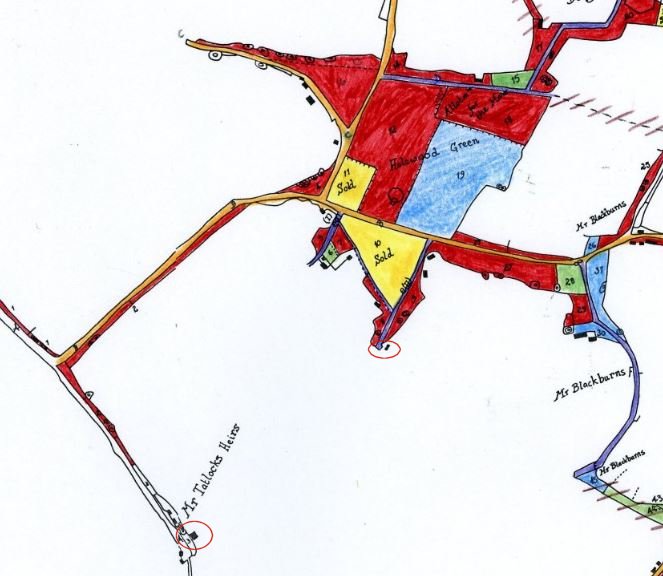
Enclosure Map 1805 William senior had grown up on Lyon's House, a farm just a few hundred yards to the west on the Macket's Lane border of the township and linked by a pathway. He came to Okells around 1871 to take on a new venture in his early thirties, at that stage living alone at the farm except for his housekeeper, the widow Mary Hesketh, but employing four local men on his farm of 80 acres. William wouldn't be alone in the farmhouse for much longer, as he already had plans to marry, and the following year he walked down the aisle with the local blacksmith's daughter, Elizabeth Hilton. The Hiltons were an old Halewood family, her father John, who had been born in the village, lived in Hollies cottages, before moving across the road to a smithy attached to the Eagle and Child.

William Grace moves to Okell's Farm - 1871 census

1872 Marriage - William Grace and Elizabeth Hilton 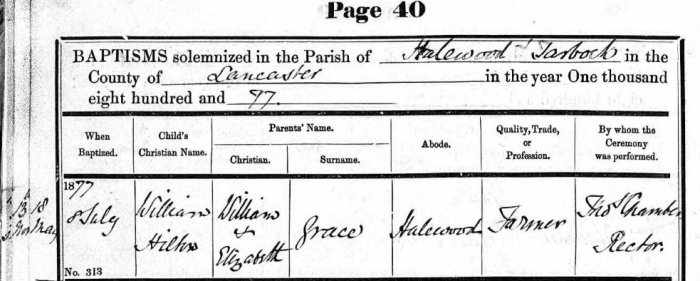
William Hilton 'Billy' Grace - born at Okell's Farm on 18 May 1877 and baptised at St Nicholas' Church. Billy, had older brothers John Hilton Grace (1874), Henry (1876), sisters Bessie (1880 and Ann (1882) and youngest brother Hilton (1886). On most farms, of course, the eldest son was usually brought up as a farmer and expected to take over the farm from his father, but it must have been clear to William that John wasn't going to follow the expected line, especially as he began to do very well at the village Church of England school, (where the rest of his siblings would also attend). He had a aptitude for Maths, and with the support of his teacher and parents, he entered Liverpool Insitute on a scholarship. From there he went on to the University of Cambridge, where he achieved a national and international reputation as an expert Mathematician. (Click his image for his full story). [I can remember a friend who attended Halewood Grange School in the late 1970s, who gained a place at Cambridge and made the front page of the Liverpool Echo, such was her achievement, as it was such a rare occurence then. Imagine the reaction towards a young farm boy in the 1890s!]
An insightful article can be found here; Landow, George P.,Post-Offce Parcels and Telegraphs, The English Illustrated Magazine (1888) On 22 March 1913, Annie married John Robertson, a telegraphist colleague from Toxteth and they moved to Preston. In 1876 the Post Office introduced a 'marriage bar', which required most female employees to resign upon marriage and forbade the employment of married women in the majority of positions. It is notable that on their marriage record her profession was left blank. Considering they were both in the same job, this may have been relaxed over the coming years.
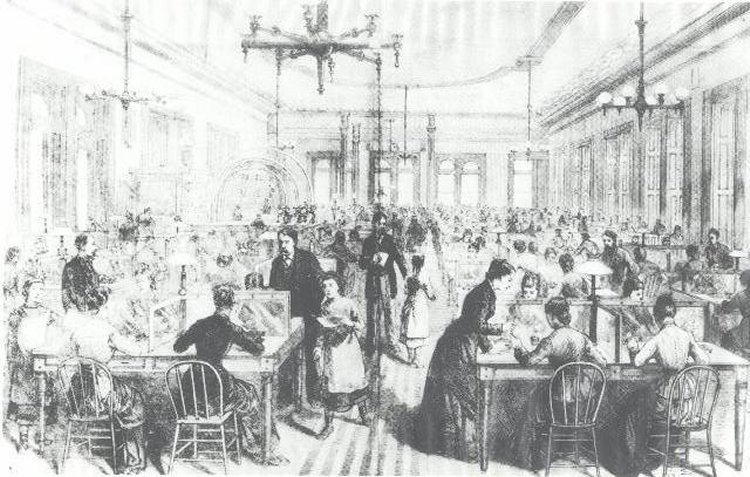
Meanwhile, the Grace family continued to run Okells Farm, athough William Hilton 'Billy' Grace left in 1913 to take over the The Court. On the outbreak of war, William's sons were working in an essential occupation, and were deemed exempt, but just as the conflict was coming to a close, William senior died on 29 October 1918, leaving estate valued at £1184 (around £75,000 today) to Henry, William and Bessie. This was a substantial amount for a yeoman farm in Halewood, although some of the value would be tied up in the house and farmbuildings, machinery and livestock, but it was still a going concern allowing Henry to continue running it with Bessie, with his mother Elizabeth still at home now aged seventy-two. William was buried in St Nicholas churchyard on 2 November. Bessie, like her sister, was concerned that she would need her own livelihood to support herself, should she now marry or if the farm was sold. In 1915 she passed the midwifery examinations and continued to practice throughout the 1920s and thirties. In August 1925 her mother Elizabeth died aged eighty, and was buried in the family plot in St Nicholas churchyard.
Lyon's House FarmWilliam Grace who took over Okells Farm in the 1870s, was born in 1836 to parents Henry and Ann at Lyon's House Farm.
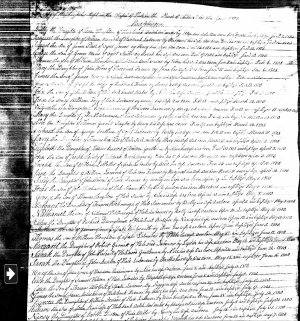
To go back a further generation, William's father, Henry Grace, was born in 1803 in Halewood to parents

Henry married Ann Hall of Bold in Prescot parish church on 23 October 1826 The couple settled first in Great Sankey, where they had four children; Alice was born in 1829, followed by sons John (1829), Henry (1831), and Thomas (1833). In 1835 they moved to Halewood, the village of Henry's birth, to take on the farm at Lyon's House in Macket's Lane. Four more children were added to the family; William (1836), Edward (1839) Ann (1841) and Sarah Ellen (1845).
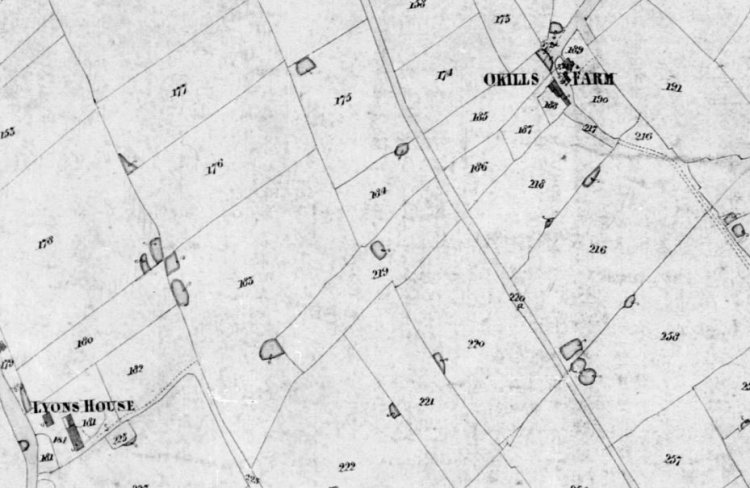
Tithe Map 1840
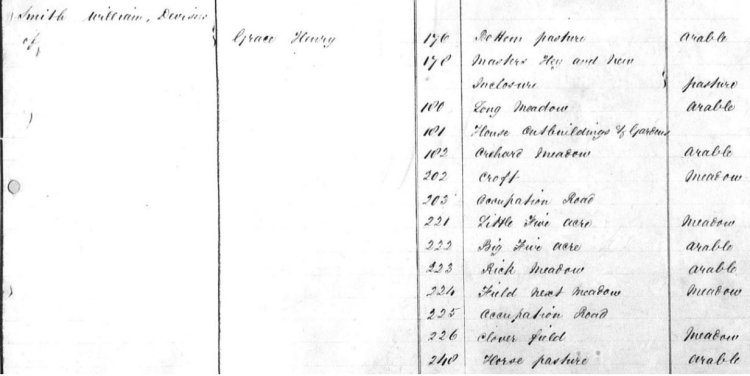
Tithe Map Apportionment (extract) 1840

Tithe Map Apportionment (extract) 1840

1851 census - Lyon's House, Mackets Lane - the family of Henry Grace

1861 census - Lyon's House, Mackets Lane - the family of Henry Grace

1871 census - Lyon's House, Mackets Lane - the family of Henry Grace The 1870s saw the family finally leave Lyon's House Farm and move away to various locations. Henry had already lost his wife Ann in 1865, who had been interred in Great Sankey, her former family church. William, as we have seen, moved a few hundred yards to develop Okell's Farm. His brother Henry possibly lived in Prescot/St Helens before emigrating to Illinois in the United States. Edward too possibly went to America to join Henry to farm land in Illinois (apart from their dates, documents don't precisly tie them both to the Lyon's House family - research continues). Daughter Sarah Ellen married Tom Nixon, a Liverpool carter, and moved to Woolton Village, where she probably took in her mother to care for her before her death (her address was given as Woolton in the burial record). Her sisters Alice and Ann also moved to Woolton Village where they shared a cottage. Alice died in 1890 and was buried in St Peter's Churchyard, Woolton, while Ann passed away in 1924, by then living in West Derby, and was interred with her sister. Thomas Grace married Bessie Greenall in 1869, whose father was a publican in Tarbock, and also moved to Woolton Village, working as a farm labourer, then later as a gardener, as did his sons. He died in 1913, and was buried with his sisters in St Peter's. Henry Grace, the head of the household, retired to Woolton, living with his daughters. He passed away there in August 1878 aged 75, and was interred with his wife Ann in Great Sankey. The story of the Grace family now returns to William at Okells Farm and his son Billy.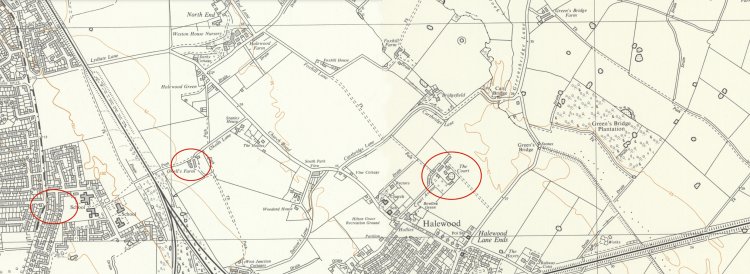
The site of Lyon's House Farm (far left) by the mid 1960s The map below shows an overlay of the site in 1905 over a modern aerial view.
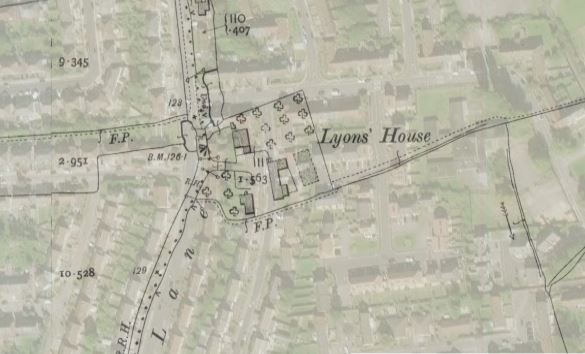
Lyon's House Farm - overlay of map of 1905 over a modern aerial view
Court Farm and William Hilton 'Billy' GraceBilly Grace worked on Okells Farm until he was in his mid thirties. By 1913, he was 36, and as both his father and older brother Henry were still on the farm, he felt he needed to move on if he was to run a farm independently using his own ideas and methods. So when John Woods let it be known he was giving up The Court, William Hilton Grace moved quickly to take it over.
It was to be a difficult start. Faced with a strike by farm workers across the South West Lancashire region for better pay and conditions, plus recognition of their union, he was then hit by the devastating blow of losing his younger brother Hilton in a boating accident. Hilton had moved to the London area in August 1907 at the age of twenty-one, where he was lodging in 41 Clavering Avenue, Barnes, in Surrey, while working as a clerk in the General Post Office engineers department. On Tuesday 30 June 1913, he hired a punt with friends on the Thames in Richmond, not far from his home. Unfortunately, the pole snapped and he was propelled into the river. It was late into the evening, nearing 11pm, and initially those with him thought he could swim, but they were watching the splashing of a man floundering. Only then did they react, but it was too late, and by the time he was recovered from the river ten minutes later, the attempts at revivial proved fruitless. The watermen who had come to his aid and were busy trying to revive him, then at the same time had to carry out another rescue as darkness fell, when one of the attending policemen stepped off the rescue raft and into the Thames, where the current swept him under nearby boats. On Fiday 3 July, Hilton was brought back to Halewood to be interred in the family grave in St Nicholas churchyard the following day. He was only twenty-eight years of age. The inquest was held the following week, where the coroner criticised the light poles that were used, and expressed his disappointment that none of his companions were in attendance to explain their actions.
Over the next few years, including war time when production needed to be efficient for the war effort, Billy worked hard to develop The Court. By 1919, he was recognised by the Royal Lancashire Agricultural Society, winning first prize for his production of rye grass. By 1921 he had purchased the surrounding farmland he was leasing from Lord Derby.
It was at this time that two young boys were given work on the farm - Bill and Harry Allen. Their family, living in Woolton village, were enduring a particularly tough time in the post-war austerity, and with their mother having seven mouths to feed her young sons took it upon themselves to walk around the local farms in search of work, 'At this time I was nine years and Bill, my brother, was 12, we decided to try and help with the housekeeping, so the following Saturday we walked two miles to Halewood and visited as many farms as we could in our quest to obtain work. By chance we saw some men working in fields, we approached the farmer with them and asked for work, he laughed out loud - a couple of boys looking for work seemed funny to him. As we walked away, he called us back and informed us that he admired our spirit and would find us work for two weeks. Our workload was for two hours each morning before school and two hours after, commencing the following Monday. To arrive in time for work, we left Woolton at 5am and walked briskly to Halewood. We were so worried about sleeping in we enlisted the help of the local knocker-upper, an elderly lady who lived in Cobden Street. Of course, there was a charge for her services, which was six pence per week, however, because we were only two youngsters the cost would be three pence to us. Billy Grace the farmer, paid us each two shillings and six pence per week, but during the second week I became extremely weary, Bill told me to have a lie down under the hedge which I did, and after a short rest felt much better. When the farmer came into the field later that day he noticed the grass was flattened where I have been laid. At the weekend when we went for our pay he had deducted one shilling and three pence from my wages! This did not stop us rushing home to proudly present my mother with five shillings for the first week and three shillings and nine pence the second one! October came, Bill and I decided we should try our hand at potato picking, we found work at the same farm in Halewood, at a rate of three shillings each per day; this meant we were each able to give mother fifteen shillings per week. She was over the moon and insisted we have sixpence each for pocket money.' Extracted from My Life in the Twentieth Century by Harry Allen
During 1929, Court Farm was hit by the heartbreaking news that foot and mouth disease had been found among the livestock and there wold have to be a cull, which eventually resulted in the loss of 165 animals. It would take some time to recover. Around that time, the young Allen brothers returned to the farm, as Harry recounts below, 'During 1929 Bill got himself a job at Court Farm in Halewood, the farm that we had worked doing the weeding a few years earlier. It was a dairy farm with 100 head of milking cows, a beef stock herd, pigs and poultry. Bill told me there was a job for me if I wanted it; the wages were double that of the Tanyard, £1 per week. With a longer working week, back to 84 hours, I took the job and began work in the spring of 1929; l did not like the Tannery, so I was overjoyed to be back on the farm.
In all, twelve men worked at the farm, so each morning we had to milk nine cows, each afternoon less men were available for milking, and I usually milked about fourteen cows, in the summer months I would have to milk about twenty-five cows each afternoon. During the cold winter mornings when we arrived for milking with the warm shippons, and the body heat of the cows overnight, it was like central heating and many times if you were tired the warmth put you to sleep. If the boss spotted you sleeping, the milking stool was kicked from under you, which woke you up pretty quickly.
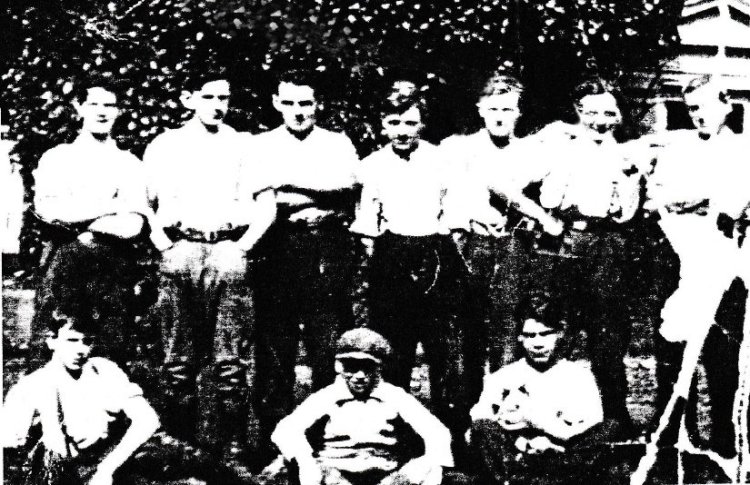
The Staff - Court Farm 1930
Back Row: First left Jim Lord, second left Bert Harbour, fifth left Bill Allen
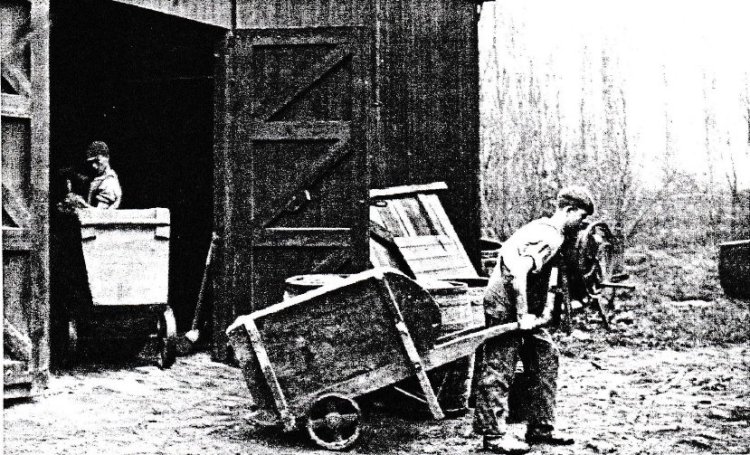
Court Farm 1930: The Allen Brothers
In the summer of 1930, I was working on top of the haystack throwing down the hay. I was required to feed the beef stock which never went out to graze, from the top of the haystack I could see away in the distance the Welsh Hills, I got this longing to be out there seeing the world. The urge was so great, that I went and put on my coat, got on my bicycle and just rode off. By early afternoon I was in Chester, with no money and no food. I was hungry and I realised what a fool I was to do this, I rode aimlessly along country lanes and in the early evening I was riding towards the canals at Frodsham, when I noticed a tent in a field. There was no one around so I went to look in the tent, it was empty, and I put my bike inside the tent hoping I had not been seen, and I slept in the tent on the floor that night, an extremely uncomfortable night it was. I was hungry and needed a drink, I passed an orchard with apples on the trees, and I went in and helped myself to two apples, which I ate, then continued on my journey again, but this time I was making my way towards Halewood.
Recent programmes about the Glastonbury Music Festival revealed land owner and farmer Michael Eavis' revolutionary idea to pump music into the sheds at milking time to relax his cows. It might come as a surprise to learn that Billy Grace was doing it almost a century before him. But it just added to the growing reputation that he was earning as the mad farmer of Halewood. There was another side to him of course, and he was also well-respected as a member of the local Parish Council and Board of Guardians. Harry Allen's time on the farm, however, was coming to an end, In the spring of 1934, I had a big row with the boss. He swore at me, and told me that if I did not watch out he would sack me. I was in a temper myself, so I told him he did not need to bother sacking me, "I am finishing now"; I put my coat on and left. Usually, if anyone left him like that he would telephone round all the local farms and tell them not to employ them. He did this with me, and I had gone straight to the farm where Vera worked (The Heyes, Lower Road). When I arrived Mr. Rawlinson was waiting for me, he said "I was expecting you, can you start now." I was over the moon, working at the same place as Vera. He needed a Cowman, and he knew I could milk, so I was given the job of looking after his four cows. On 8 January 1935, Billy's older brother died at Okells Farm aged sixty. He was still running the farm, but left just £13 2s 4d to his sister Bessie. He was laid to rest in the family plot in St Nicholas churchyard. Of the siblings he was survived by only Bessie who continued to live in the farm cottage, and Billy who ran the farm.
* The note opposite Bessie's name reveals that she was serving as an Air Raid Warden and in the The Royal Observer Corps (ROC) (No.4 Whiston) during the Second World War. This was a civil defence organisation intended for the visual detection, identification, tracking and reporting of aircraft over Great Britain.
In 1941, Billy Grace took the reluctant decision to give up dairying and concentrate on arable as it was no longer profitable. The auction was arranged for 25 September 1941 and the herd was sold off.
In 1944, plans were announced for the urban development of Halewood, which certainly caused a stir among the rural community. It's a likely that at this point Billy Grace was concerned as to how much of the old Halewood would be swept away and how much provision there would be regarding the preservation of open spaces for community use. As early as December 1932 he had offered a site to St Nicholas Church for a new parish hall. Three sites were considered, and one opposite the old school house was selected (James Eccles, 'History of St Nicolas Church 1839-1939 page 64). Nothing further seems to have been done at this stage, and later the interruption of war no doubt delayed matters further. In 1944, he then approached the local Whiston Rural District Council and made an offer to donate 9½ acres of land (the original selected site) facing St Nicholas Church bordering Hollies Road, to be used as playing fields for the benefit of the community. The committee resolved to refer the offer to the Surveyor currently at work on the development plans and accepted Billy's Grace's generous donation, which would now move on to the conveyancing stage.
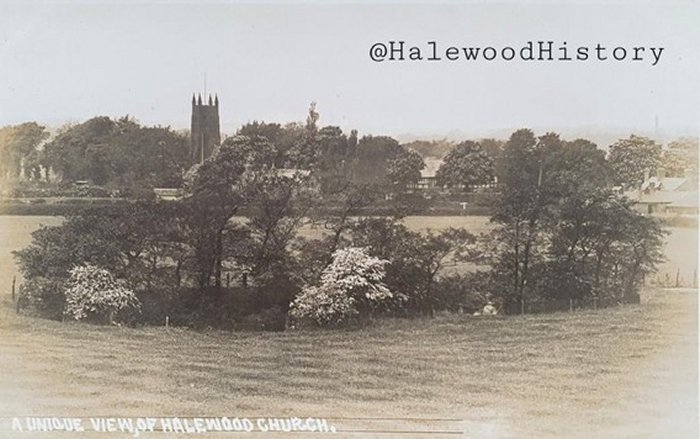
The field (c.1910) which later became Hilton Grace Recreation Ground. (Photo - @HalewoodHistory/Sam Best)
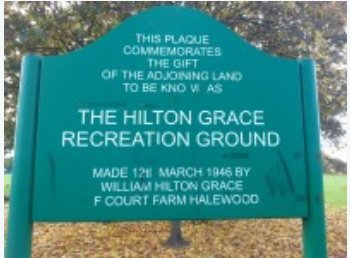 It took some time from Billy Grace's offer in October 1944, but by 12 March 1946, the Hilton Grace Recreation Ground had become a reality.
It took some time from Billy Grace's offer in October 1944, but by 12 March 1946, the Hilton Grace Recreation Ground had become a reality.
It was named not after himself, but in memory of his younger brother Hilton, who he had tragically lost thirty-three years earlier. Furthermore, in mind of his original offer of 1932, there was a stipulation that it should also be the site of a purpose-built village hall for the benefit for all in the community. Billy had seen his dream realised of saving a plot of land from the developers for all to use, which remains the situation today.
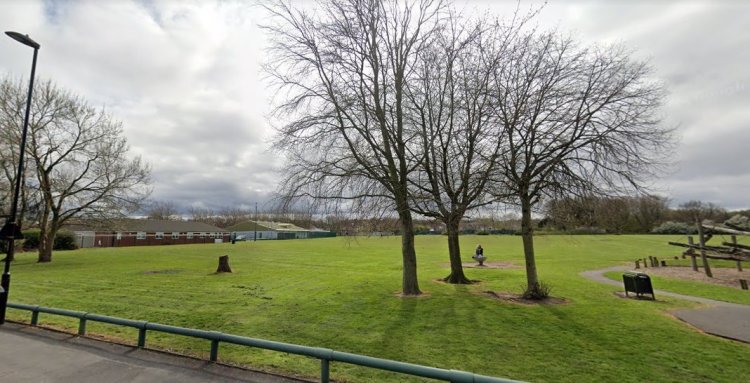
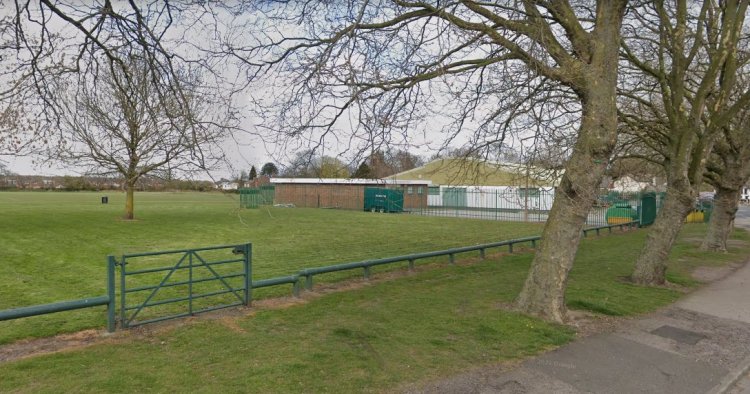
The Hilton Grace Recreation ground today
We had a very mild winter that year (1947) until the end of March; at which time we had the worst frost I had ever known, it was freezing until the end of May. All building work came to a standstill and once again we had no income. I decided to go back to the land. I managed to secure a job at Court Farm, where I had started my working life in the twenties. It was no longer a dairy farm, they had sold the cattle during the war because of feeding difficulties. The farm was now arable, all fieldwork. Vera was getting better and stronger every day, my sister Madge and her husband had been living with us for a few months, but had now moved to a house in Woolton. In the spring of 1948 working at Court Farm, I had a row with my boss Billy Grace, I told him that he was like my old Sergeant Major in the Army, but as I wasn't in the Army now I didn't have to take that sort of discipline, so he sacked me. That was the one and only time I have ever been sacked. I found a new job straight away, working for a dairyman, Jack Williams, in Church Road Halewood. I was to be his milk roundsman on the new prefab estate in Netherley. I had a horse and wagon at first, the horse was called Dolly, she knew the round better than I did! Harry may have had his ups and downs with Billy Grace, but there were several farm workers at Court Farm who put in many years working for him. One of them, George Hall, who lived in a tied cottage on Church Road was even recognised at the Royal Lancashire Agricultural Show where he was given an award for 45 years service. By early 1952, plans were in place to build a much needed village hall on the Hilton Grace Recreation Ground, as stipulated in the terms of the conveyance. Fund raising was well on the way to reaching the target of £1,700, with £1,100 already raised, which was boosted by £450 coming from the success of Halewood Festival Week in April 1952. This ensured building could begin and the brick foundations were laid that month. It was planned to build a wooden structure, 98 feet by 31 feet, with a wooden verandah down one length facing the field. It was a facility desperately needed by the growing community, which for decades had previously used the local public houses (Derby Arms and Eagle and Child) for meetings, and the old pavilion to the rear of the Derby Arms for larger functions such as weddings (pictured below to the left of the rear of the Derby Arms). 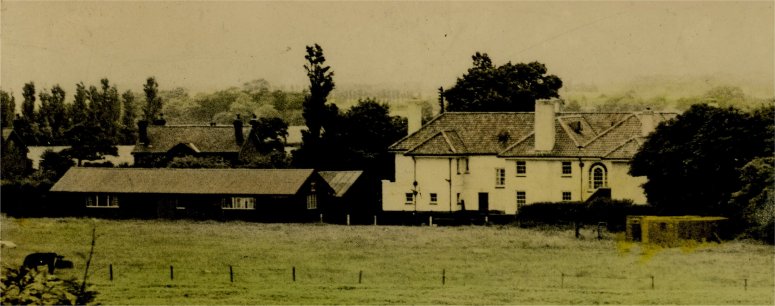
After years of hard work by the enthusiastic Halewood villagers, the village hall was ready to be officially opened in October 1952. The building was bought at Prestatyn for £1,700, all the money being raised by local effort, and transported to Halewood, where it was erected on the new foundation. Much of the plumbing, drainage, electrical and general installation was done by voluntary labour. On Monday 6 October, there was a full meeting of the Halewood and Tarbock Committee and Mr W.H. Grace was unanimously elected president with County Councillor F.S. Quayle as vice-president. The grand opening day was on Saturday 11 October at 2.30pm, when 75 year-old Mr Grace placed the key in the lock and declared the new building open, before also officially opening the Halewood Women’s Institute Village Fayre.
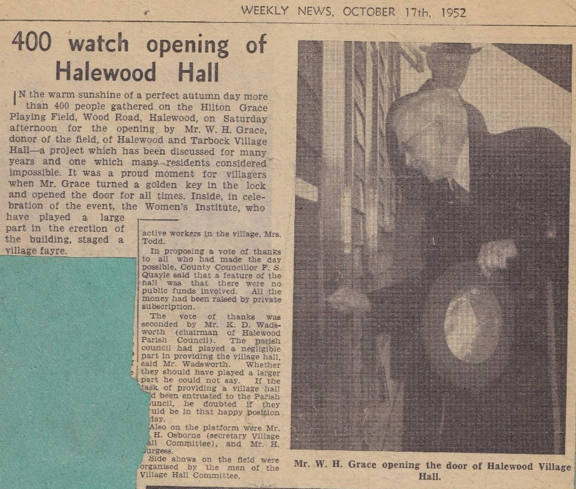

The original village hall, opened 11 October 1952
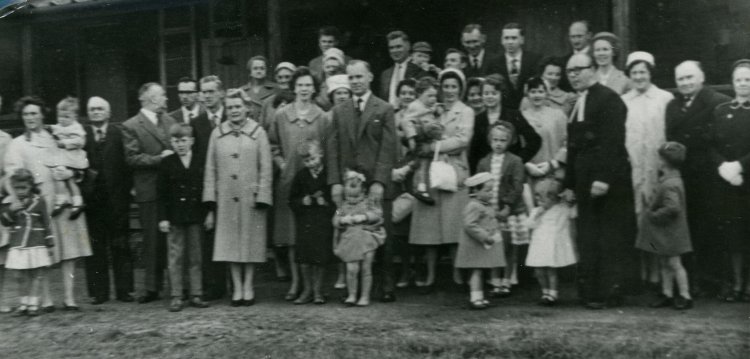
Halewood Methodist Church congregation in front of the original village hall The congregation would later have their own church of St Mary's, Leathers Lane, but met in the Village Hall from its foundation. The author is on the photo - in the school cap (centre) held up by my father Bill Royden. My mother, Hazel Royden, is to the left of the minister Rev Wilf Green, and my sister Gillian (who still lives in Halewood with her family) is at the front wearing the hat, standing side-on. I can also remember being part of the cubs and scouts which met in the hall before moving to their purpose-built hut behind the old school house.

Map of the mid-1960s showing the Hilton Grace Recreation Ground
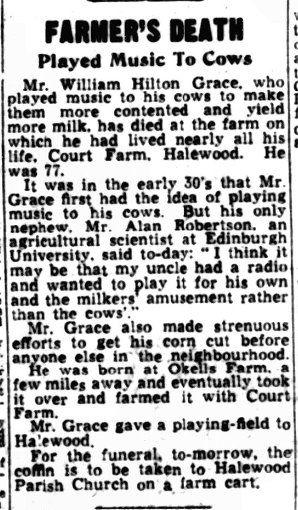
William Hilton 'Billy' Grace died on 12 August 1954 aged seventy-seven, and was interred in the family grave in St. Nicholas Church. He left a lasting reputation that is gradually being forgotten as those that remember him are passing too, but he did leave a lasting gift for the community of Halewood that still bears his name. He also left estate worth almost £38,000 (the equivalent today of £1.1million) split between his sister Bessie and nephew Alan Robertson. Early in 1955, St Nicholas Church received a legacy from the estate of W.H. Grace. Soon afterwards at a meeting of the Church Council, tribute was paid to his generosity to the church and to all the work he did over the years to the Church and Churchyard. A letter of appreciation was sent to his sister Bessie Grace. By the mid 1960s, as acre by acre, the farmland in Halewood was swallowed up by the advancing spread of housing, Bessie Grace knew she would lose her home at Okells Farm, where she had spent her entire life. In 1966, she planned to move into her brother Billy's home at Court Farm, which she now shared ownership with her nephew. But like Billy, she too wanted to leave a lasting legacy for the people of Halewood. This took the form of a children's playground situated on the land given by her brother.
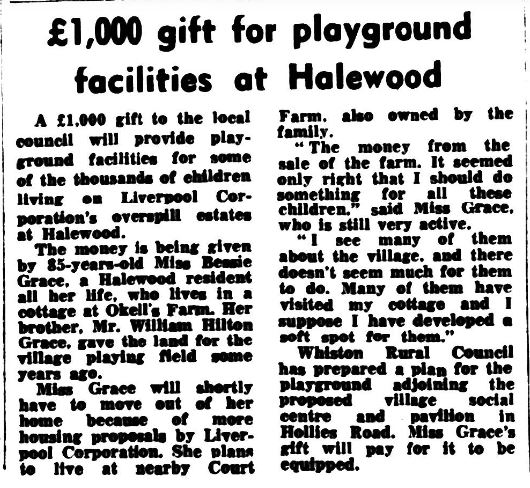
Liverpool Echo, 29 June 1966
Bessie decided against living alone in the large Court Farm house, and instead moved into an adjacent house at 12 Court Avenue in 1967, the road that led up to the farm. Meanwhile in 1965, Liverpool Corporation had put forward the plans for further development of the Church Road-Gerrards Lane area of Halewood. The plans were for 4,250 houses to be built in five phases, adding an additional population of 20-25,000. In preparation for this, the land was purchased (in most cases compulsory), and all the houses in that area were demolished by Liverpool Corporation, including Okells Farm, South Park View, the whole of Halewood Green, and the Railway Cottages. By 1969, a main road had been built around the area (now called Okell Drive), drains etc had been put in and all was set for the first houses to be built. Then later in 1969, the whole project was postponed for a year, and in 1970 it was cancelled. In the 1980s it was sold for private development.
Bessie passed away there on 8 September 1975, and was the last of the Grace family in Halewood. She was interred in the family plot in St Nicholas churchyard. From the sale of Okells Farm and land, she had amassed a small fortune - £129,794 (equivalent to £1.5 million which she left to her nephew Alan, as well as her share of The Court.'The cost of reordering and furnishing the chancel and sanctuary was given in memory of Bessie Grace by her family. Miss Grace had been a member of St Nicholas since her birth in 1880. She had been born at Okells Farm and lived there until compulsory purchase of the farm by Liverpool Corporation necessitated her move to a house in Court Avenue in 1967. Though her later years were in this way disturbed by the changes in Halewood, far from appearing to resent the changes, time and again she went out of her way to show welcome and friendship to newcomers, especially chidren. When she died in 1975 at the age of ninety-five, she was still actively concerned with the church and its members.'After the death of his uncle Billy, Alan Robertson continued to manage the affairs of both Okells and The Court. Contrary to reports elsewhere, he never lived at The Court, as his working life and family by then were in Edinburgh. Bessie was the last of the Grace family in Halewood, while Alan retired in 1985, and died four years later in Edinburgh in 1989, aged sixty-nine. Alan's family offered the farm and surrounding estate to Whiston Rural District Council who purchased it on 10 July 1970. Okells Farm was demolished during the late sixties, and The Court would go the same way shortly after. However, unlike the Okells estate, The Court area has never been built upon, and remains today like the recreation ground, as a public open space, for the benefit of everyone in the community. Walkers can still see hints of former buildings with foundation stones here and there, plus the pool which was once part of the water supply to the brewery.But while plans were in place to develop the area as a public amenity, the story of the The Court site was not done, and was soon to reveal its incredible archaeological history
Court Farm Excavation
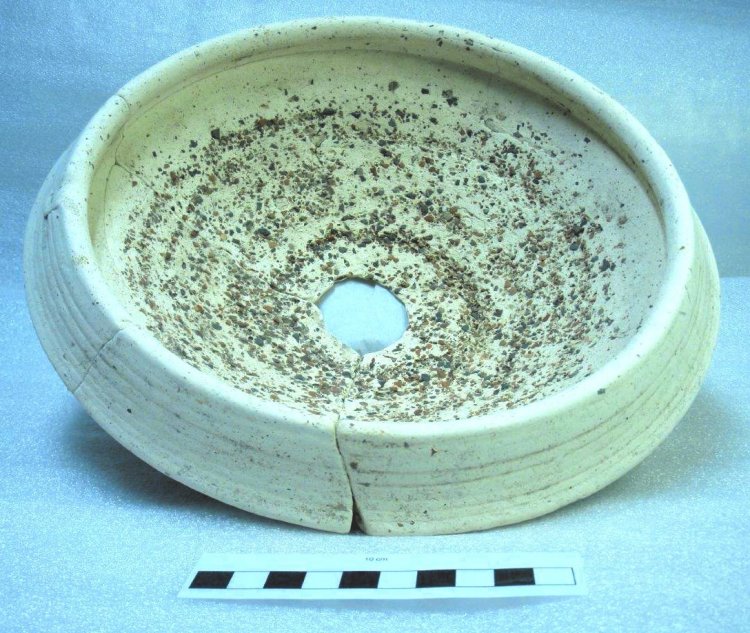
The Court Farm mortaria (photo: NMM)
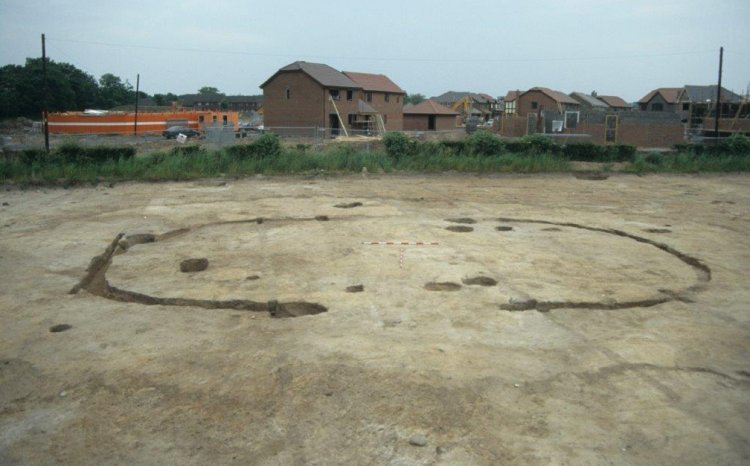 An impressive photo of the remains of a
An impressive photo of the remains of a Romano-British roundhouse at Court Farm. Contrasts in soil colour created by different materials decaying or being deposited are often the way archaeologists identify features on a site. The difference in soil colour isn't often as striking as this! The timbers of this elongated roundhouse (a local variation on a round roundhouse) have rotted leaving dark soils. ( Museum of Liverpool Archaeology/Vanessa Oakden on Twitter - photo: NMM)
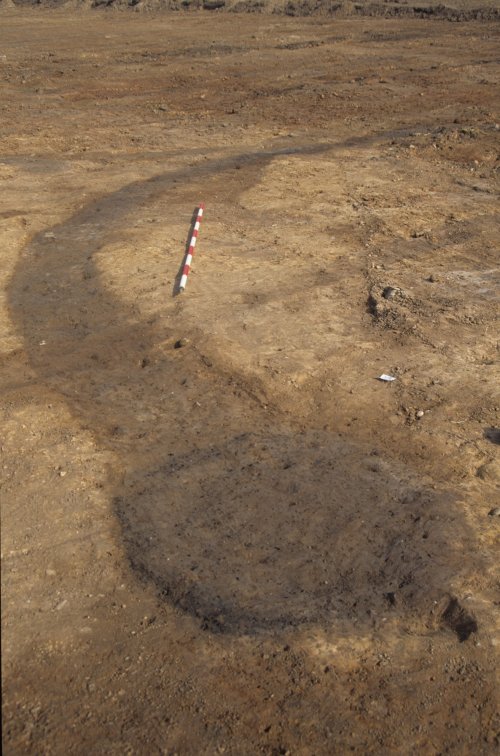
The Court Farm roundhouse close up (photo: NMM)
Romano-British oval building under excavation at Court Farm, Halewood
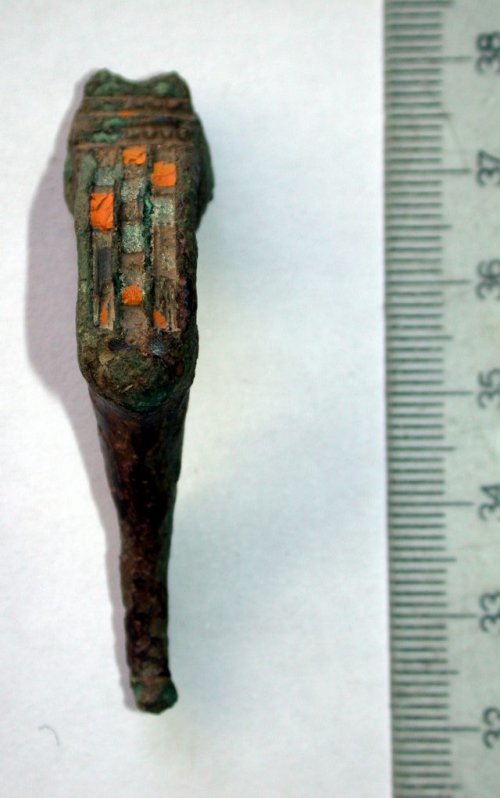
2nd century 'Wirral' type brooch from Court Farm, Halewood
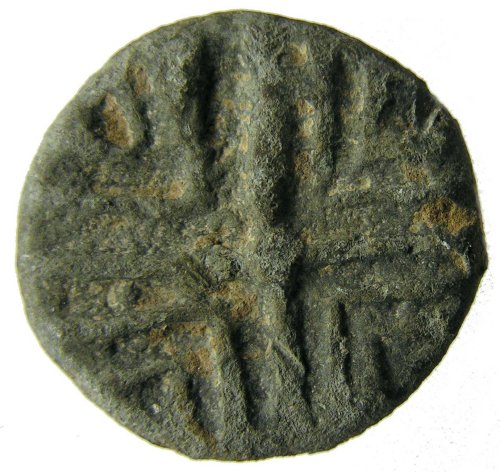
Late medieval to post-medieval lead token
This late medieval to post-medieval lead token was found during excavations at Court Farm, Halewood. Lead tokens had different uses including as gaming pieces, tallies, wights and tickets and are often made locally and are therefore difficult to date.
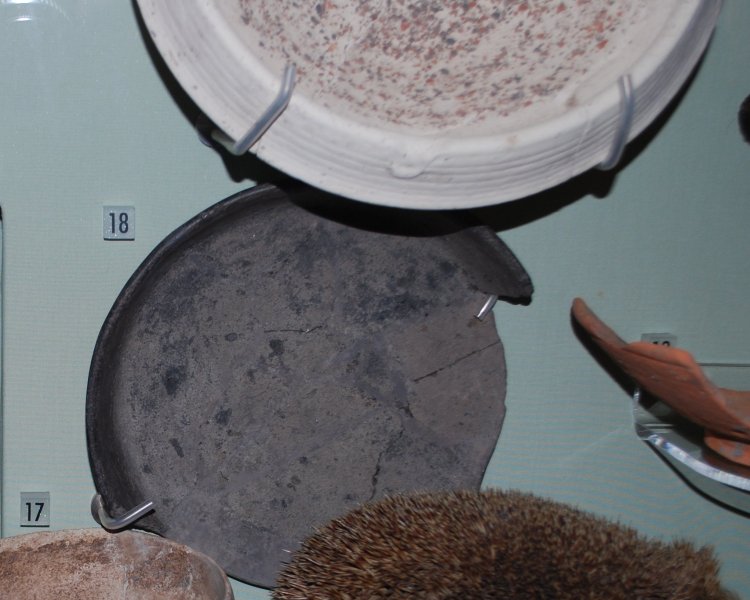
Court Farm black burnished ware dish, exhibition case, Museum of Liverpool (photo: Mike Royden)
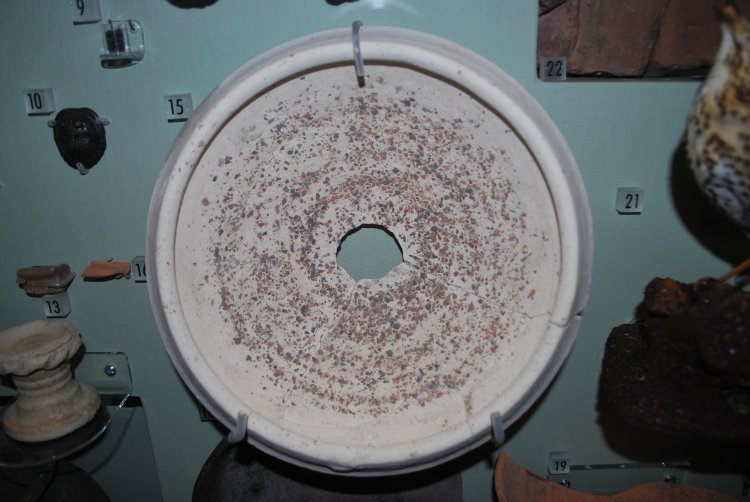
Court Farm Mortaria, exhibition case, Museum of Liverpool (photo: Mike Royden)

Exhibition case, Museum of Liverpool (photo: Mike Royden)
Adams, M. H. & Philpott R. A., Excavations at Court Farm, Halewood (Forthcoming).
The Court Farm site today - Court Farm Woods
In 2011/12 the Court Farm Woods Association was formed with support from Knowsley Council and Leather’s Lane & Wood Road Community Association. These dedicated local residents helped to secure over £80,000 investment for Court Farm Woods for woodland and habitat restoration, as well as further improvements to paths signage, seating and infrastructure to make the woods a high-quality community woodland for the residents of Halewood village to enjoy. Further financial support came from Cory Environmental Trust in Britain, Big Lottery Fund Community Spaces, and the Forestry Commission.
Return to Halewood Buildings Page
Visit the Royden History Index Page listing web sites designed and maintained by Mike Royden No pages may be reproduced without permission copyright Mike Royden All rights reserved |